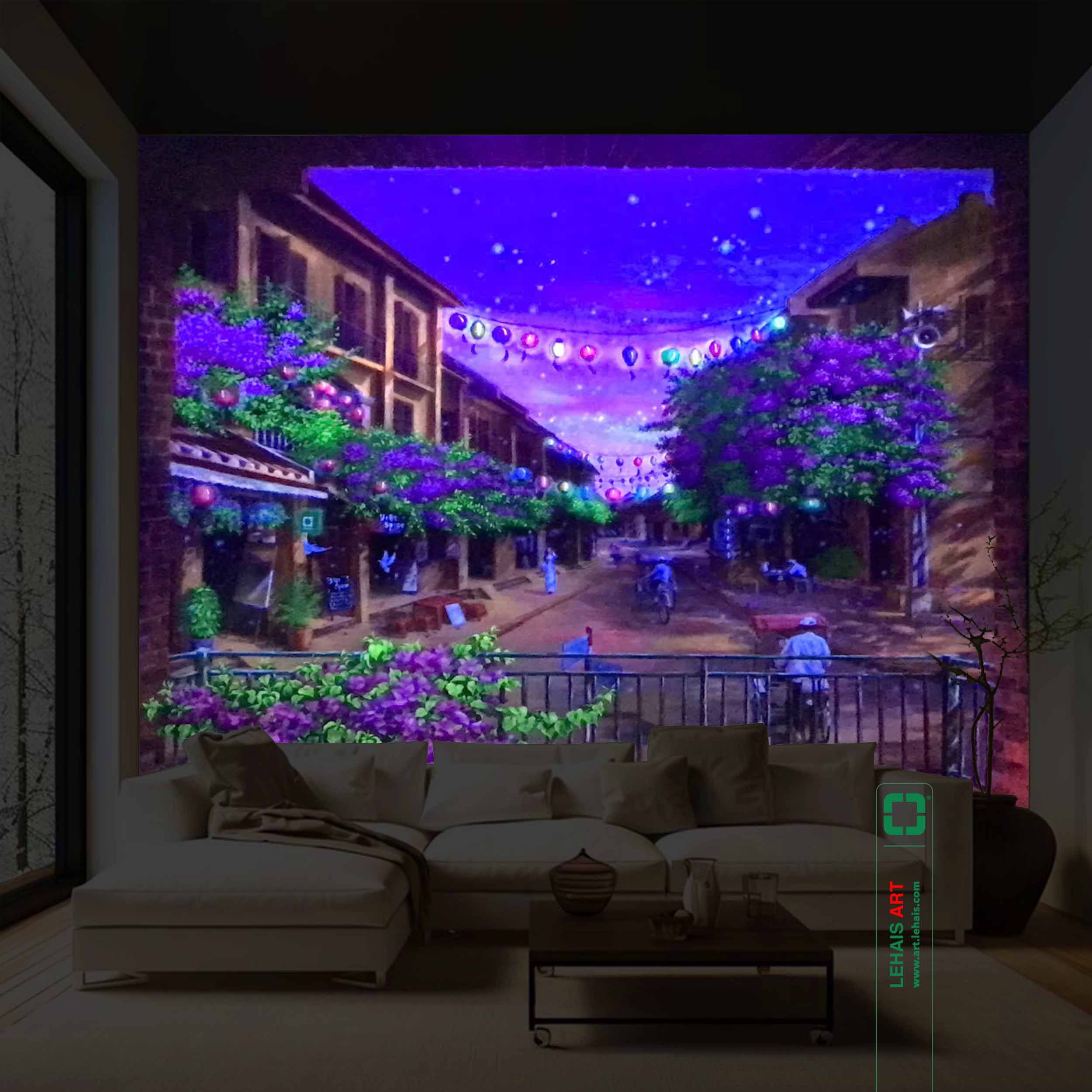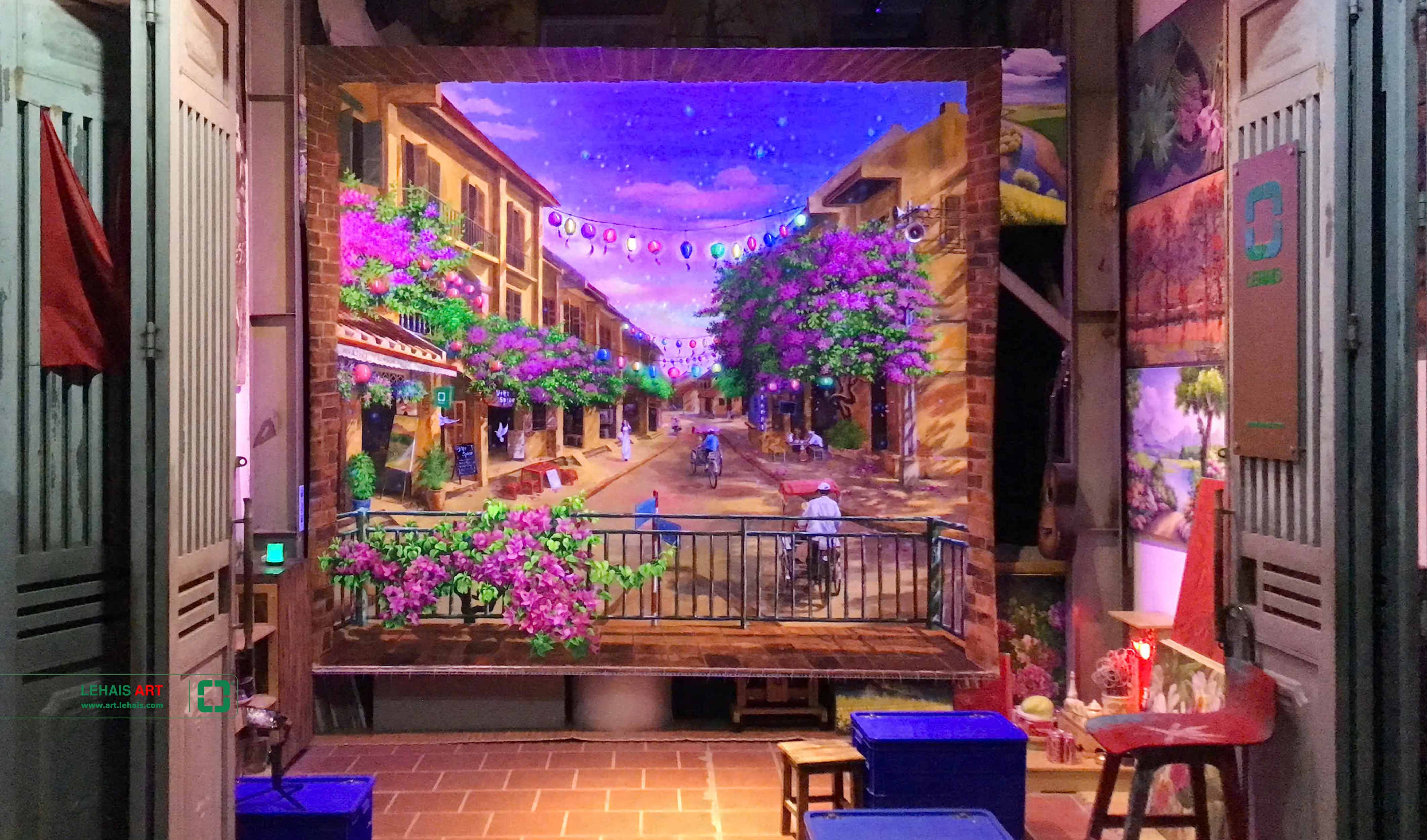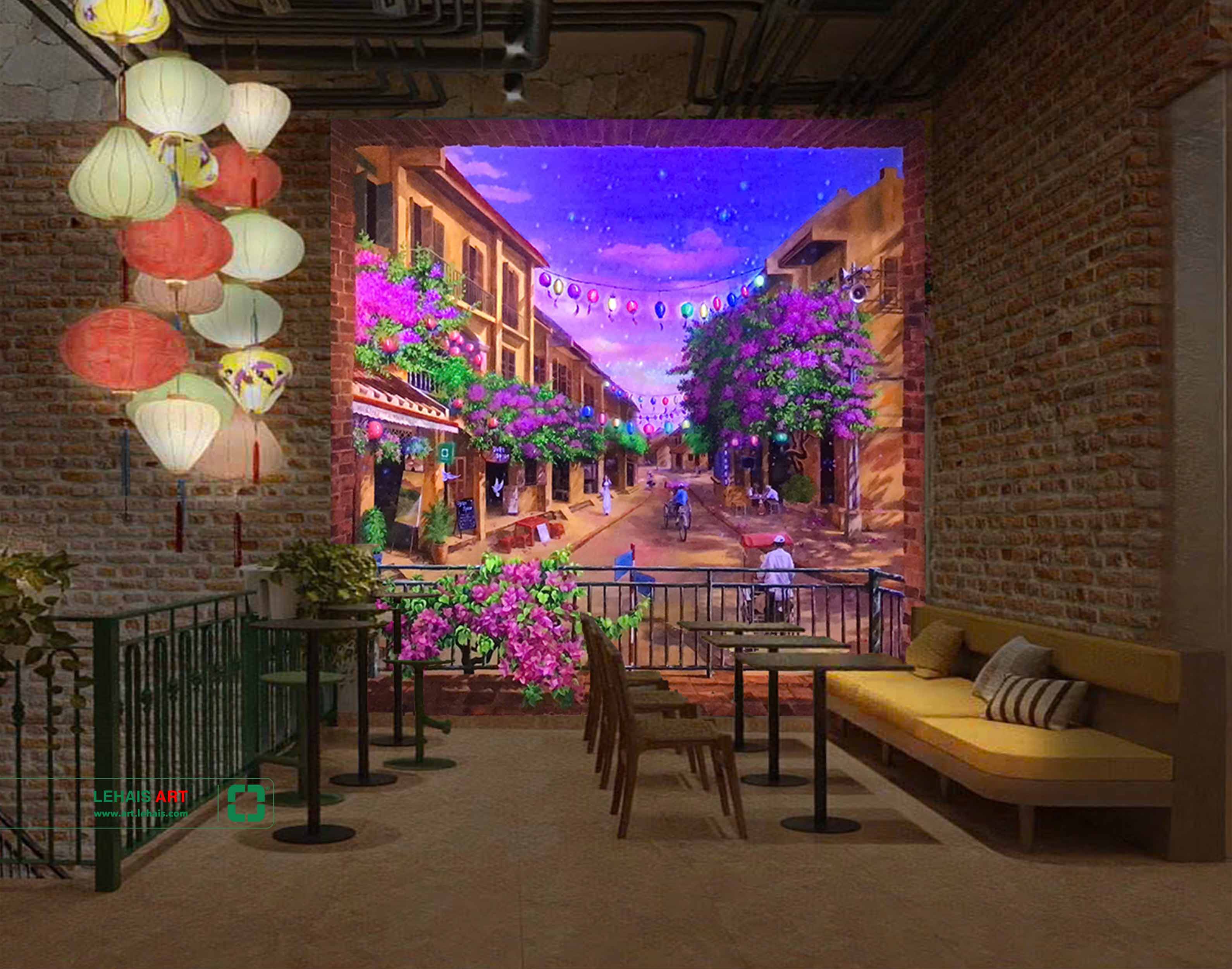The essence of tradition and pride of Vietnamese Fine Arts - Art lacquer painting
When referring to the Lacquer painting line, the world art world immediately thinks of Vietnamese art. The painters Nguyen Gia Tri and Pham Hau are those who have explored and researched, to coordinate with new methods of lacquer, and at the same time applied a combination of Western drawing principles to create a style and school. of Vietnamese painting in the early twentieth century.
They are also outstanding figures in the list of artists considered as the first pillars of contemporary Vietnamese Fine Arts.
Development history of lacquer craft
Lacquer Painting: from Indochina Fine Arts School. Work: "Villagers". Artist: Pham Hau., 1934
Lacquer: It is a combination of material (paint) and technical action (grinding). Based on archaeological artifacts, the objects using paint materials existed in our country about 2,500 years ago. Son is extracted from the mountain, which grows abundantly in the Northern midlands, especially in Phu Tho. The ancients used paint made from the resin of the Son tree (called the paint) to cover objects or worshiping objects with wood, pottery ... in order to increase the durability and then gradually develop into decorative paintings, drawing one more number of lines, patterns, natural landscapes to create more uniqueness for the product.
"Northern midland landscape", Author: Pham Hau. 1940-1945, lacquer on wood, including 8 panels, each plate size 124.5cm x 33cm.
Traditional painting is limited to black background colors, lotus red, cockroach brown and gold and silver motifs. The artist who works in painting is called the profession of "painting with gold lipstick". Around 1930, painters of Indochina Fine Arts School such as Tran Quang Tran, Pham Hau, Tran Van Can, Nguyen Gia Tri ... cooperated with artist Dinh Van Thanh to experiment and put the technique of painting in gold painting to work. art picture. The terms "Lacquer" and "Lacquer painting" have that word.
The famous landscape vase of painter Nguyen Gia Tri: "Along the mosquito net". Material: lacquer, size: 160x400cm, 193
In addition to the artistic level, the lacquer painter must have a very high technical level. Through many times of drawing, drying, grinding flat. After shaping the work, the picture is covered with a final layer of paint, dried (sealed) and ground to allow colors to appear. Finish grinding, use your hands to rub coal powder to gradually shine on the surface. It takes 15 to 20 days to make a simple, small-sized work. Great works sometimes take months or years.
In 1925, at a working session at Van Mieu - Quoc Tu Giam, French painter Josehp Inguimberty was amazed by the beauty of the long-standing golden lacquer paintings. He immediately suggested to Mr. Victor Tardieu, Rector of the Indochina College of Fine Arts, Hanoi, now the Vietnam University of Fine Arts to put the paint material in research and practice programs. Since then, lacquer material has been continuously created, from the two traditional colors, red and black cockroach wings, later with more color materials such as gold, silver, lipstick, key, eggshell, shells, etc.
"Young woman in the garden", Size: 160 x 400 cm, Author: Nguyen Gia Tri, Material: lacquer
Lacquer is the unique advantage of Vietnamese Fine Arts, the exploration and technical development of the senior artist class who has turned the traditional craft of painting (Vietnamese painting) into the lacquer technique. However, the word used to refer to lacquer is often understood to mean Japanese or Chinese handicrafts. In fact, grinding technique is the big difference between foreign handicrafts and Vietnamese lacquer paintings.
Painting lacquerware has the "paradoxical" principles: if you want the paint to dry quickly, the painting must be incubated in a wind-tight incubator with high humidity. If you want to see pictures, you have to wear them out to see them. Most painters agree that lacquer painting techniques are difficult and random, so many seasoned artists are also surprised by the effect achieved after sharpening paintings.
"Lotus". Author: Pham Hau.
Pioneering artists (banyan tree) in Vietnamese lacquer painting art
Contributing a great deal to bringing lacquer to develop as high as today, must include the senior painters like Pham Hau and Nguyen Gia Tri. They are the leaders of the peak period of lacquer painting (1938-1944) with typical works such as "Villagers" (1934), "Northern Midlands Landscape" (1940-1945).
Talking about painter Nguyen Gia Tri, his lacquer paintings are very beautiful to the eye, while painter Pham Hau's paintings contain a deep, pure interior and are more traditional. This is also the quintessence shown in every work of painter Pham Hau.
"Thay Pagoda", Author: Pham Hau. 1934. Material: wood lacquer, consisting of six panels, each plate size 104cm x34cm
The first Vietnamese artists studying at Indochina Fine Arts School were the ones who discovered other colored materials such as eggshell, snail, bamboo tree, etc. and especially incorporating grinding techniques into unique lacquer techniques to create real lacquer paintings. The terms lacquer and lacquer painting also appeared from that time.
In fact, since 1925, the Indochina Fine Arts College has paid attention to the lacquer material and invited the artist Dinh Van Thanh in the Ha Thai lacquer village to show how to use our paint colors. But they only consider it as the technique of making handicrafts, not the art. That is why painter Nguyen Gia Tri left the school to find a new technique for the development of lacquer art. After two years, listening to the advice from friends Nguyen Gia Tri to return to school to continue with the seventh-grade students, it took him ten years to obtain the prestigious degree from the Eastern College of Fine Arts. Ocean. In return, he painted a lot of oil paintings and lacquer paintings; and become famous for her work.
Artist To Ngoc Van evaluated: “Up to Nguyen Gia Tri's experiment, our painting style is no longer an ordinary fine art product. In the soul of the maker, it has been raised to the highest level of art ".
At the same time, paintings by Nguyen Gia Tri and Pham Hau were ordered by many domestic and foreign collectors. Many collectors ordered paintings from when he was just a rough idea or sketch of a work. However, he is a difficult person, very strict with his profession, so he cannot compose much. The artists of his contemporaries all said that Tri was rarely satisfied with one of his works, each of which he spent a lot of time and enthusiasm to do, if not, he would do it over and over again. when i see you like that
In 2013, Nguyen Gia Tri's paintings were recognized as a National Treasure. Currently on display at the Saigon Fine Arts Museum, after nearly a century, the formation and development of Vietnam's lacquer, fine arts and lacquer painting lines have become a very traditional artistic and cultural feature. Vietnamese art and received international recognition. Many lacquer works in the twentieth century have become the common cultural property of humanity.
“Cá vàng ba đuôi“. Tác giả: Pham Hậu (1903-1995). Chất liệu: Sơn mài
The main stages of lacquer engineering
It can be said that lacquer technology only follows one general principle; But there is a big difference in the experience and techniques of each individual, each family. In addition, it is transformed in techniques to serve different purposes: making pictures, making statues, decorating objects, painting gold coating ... The lacquer technique has three main stages: wrapping, decorating, grinding and polishing.
- Dressing-up: is a specialized term. In the old days, people who made the cuttings of wood of objects that need to be painted were often made using bait paper, which is made from that wood, so it is very tough and more durable than fabric. The way of bundling is carried out as follows: using alluvial soil - nowadays the worker can mix stone powder with paint - crush with paper and cut, close the cracks of the wooden board. After that, there must be mortar to carry fish to install and attach paint to the horizontal wooden braces behind the plate.
Body is a wood or plywood board that has been painted many times and covered with many layers of fabric, dried and ground flat. The process - making a sheet consists of many meticulous, complex steps that take about 20 to 30 days with the number of paints and bundles of 8 to 10 times. Body is usually done by skilled painters. Painting on the base is called lacquer painting. The painter used paint to mix various kinds of pigments, in coordination with gold, silver, eggshell ... to make his work. Handle the sheet carefully, prolong the life of the object to be painted, each lacquer painting can have a lifespan of up to 400-500 years.
- Decoration: When having the aforementioned plate or the flower vase carvings, or other sets of objects, the craftsman of the items must first make the stages of attaching and gluing the coloring materials for the work. products such as eggshell, mother-of-pearl piece, gold, silver ... then coated with paint and then ground flat, followed by color.
With painting techniques and furniture such as: incense, diaphragm, sentence ... the worker must work in a closed room and make a screen around to avoid the wind blowing away the materials: gold, silver, and avoid dust getting on wet paint.
- Grinding and polishing: Because the varnish has been mixed with the color to draw, it creates a shadow that sinks in the color core and creates a deep depth of the work, so after each drawing, it must be sharpened. The ancients used dried banana leaves to make rough paper. Up to now, the principle of final polishing has no substitute for this manual method because lacquer paintings are not allowed to be coated with varnish. That is the unique point of lacquer painting. The success of a lacquer painting depends greatly on the final stage. There are a number of traditional materials used for grinding and polishing, such as crushed oval charcoal, tangled hair, chicken liver stone, etc.
Lacquer, although a bit late, has confirmed its value very quickly
Paint, also known as live paint, is a commodity that has been heavily produced by Phu Tho province for sale to China and Japan. From 1931 onwards, the use of our paint was similar to that of Chinese paint and Japanese paint only to cover objects to make the splendor of everyday objects such as trays, caskets, clogs, and worshipers. long sentences, dishes, decorations such as sentence, diaphragm, screen ... with traditional colors, roughly only: lipstick, black, brown, cockroach, gold, silver; only works to decorate objects.
From the research and development of pioneering painters who break down our paint to completely switch to lacquer, our paint has come out of its inhibitory shell and advanced on the vast path of artistic creation. to the strange heavens. From the casket, the clogs, it transcended into a precious framed painting, from an auxiliary means to paint objects, it became a unique means of expressing the artist's soul.

















